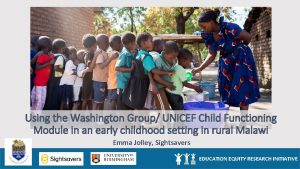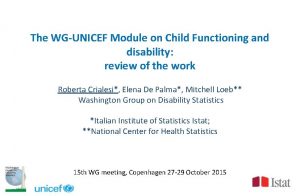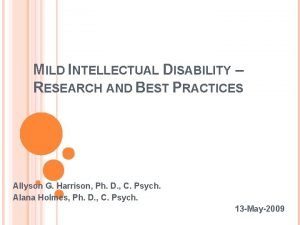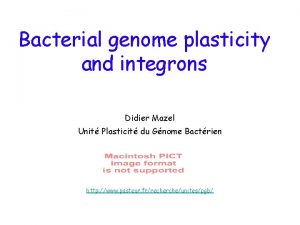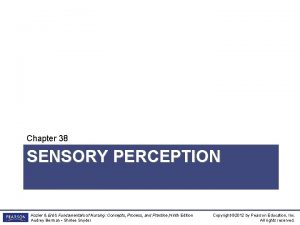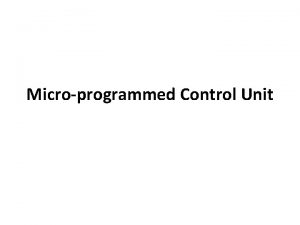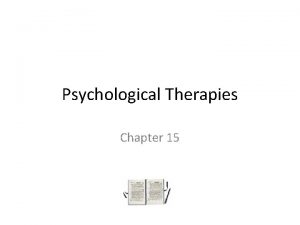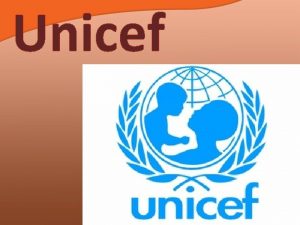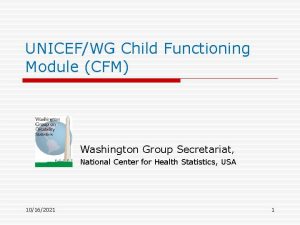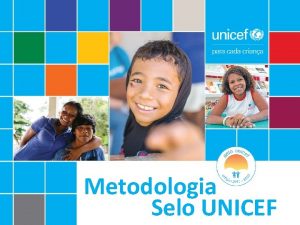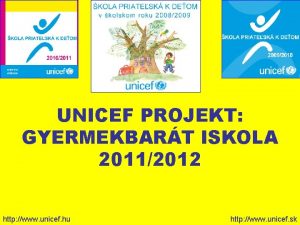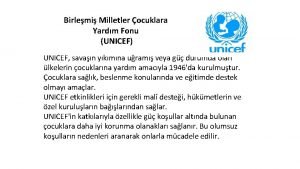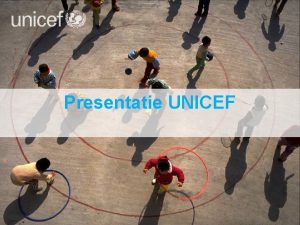Using the Washington Group UNICEF Child Functioning Module














- Slides: 14

Using the Washington Group/ UNICEF Child Functioning Module in an early childhood setting in rural Malawi Emma Jolley, Sightsavers EDUCATION EQUITY RESEARCH INITIATIVE

Background & rationale • Many approaches to measuring disability – depends on objective • Standardised and internationally validated tools and metrics are vital to measure disability among children and monitor their participation in services and interventions. • The recently launched UNICEF/ Washington Group Child Functioning Module (CFM) builds and improves the UNICEF 10 Question Screen for disability • Evidence on how children in LMIS access ECDE services is scarce, and evidence on children with disabilities is particularly hard to come by EDUCATION EQUITY RESEARCH INITIATIVE

UNICEF/ Washington Group CFM • Developed jointly by the UN Statistics’ Washington Group and UNICEF. • The purpose of the tools is to identify the subpopulation of children who are at greater risk than other children of the same age of experiencing limited participation in an unaccommodating environment. • NOT DIAGNOSIS • Two separate sets of questions appropriate for the child age: 2 -4 years (16 Qs) and 5+ years (23 Qs). • Assesses functional difficulties in children in a number of domains, including hearing, vision, communication/comprehension, learning, mobility and emotions. • Flexible analysis. We defined ‘disability’ as a response of a lot of difficulty or cannot do at all in any one of the domains. EDUCATION EQUITY RESEARCH INITIATIVE

UNICEF/ Washington Group CFM Example of questions: The next questions ask about difficulties your child may have in doing certain activities… 1. Does [name] wear glasses? 2. When wearing his/her glasses, does [name] have difficulty seeing? Would you say… 3. Does [name] have difficulty seeing? Would you say… Yes No No difficulty Some difficulty A lot of difficulty Cannot do at all

Tikule Limodzi: Let’s grow together! • Thyolo district, rural Malawi • University of Birmingham, UK; Chancellor College, University of Malawi; Sightsavers • 3 year research partnership funded by ESRC/ DFID • Objective: To develop a disability-inclusive training module for caregivers and tested how the new training affected children’s development. EDUCATION EQUITY RESEARCH INITIATIVE

Study design Phase 1 Phase 2 Phase 3 • Literature review • Community based participatory research • Redesigned training curriculum • Cluster randomized control trial: • Baseline survey • Endline survey • Case studies of individual families/ caregivers • In-depth interviews to understand process of embedding in policy • Phased, mixed-method study • Multi-disciplinary • Baseline survey: what is the prevalence of disability and developmental delay among children attending early childhood education? EDUCATION EQUITY RESEARCH INITIATIVE

Study methods: baseline survey • 48 ECE centres chosen at random, • 20 children in each aged 2 -6 years were randomly selected and enrolled in the study: 960 children in total • The CFM was administered to the parents/ guardians of children in addition to other tools including two domains of a locally developed and validated Malawian Developmental Assessment Tool (MDAT). • Data were captured by trained teams using electronic data capture devices and analysed using Stata version 15. • A binary measure of disability was calculated and univariate associations with other data calculated using chi-squared tests. • Cohen’s Kappa coefficients were calculated to understand the levels of agreements between the CFM and MDAT. EDUCATION EQUITY RESEARCH INITIATIVE

Results Profile of children Prevalence of disability N (%) Total 935 100 (10. 7%) Sex Male (n=418) 48 (11. 5%) Female (n=517) 52 (10. 1%) 2 -4 years (n=730) 40 (5. 5%) 5 + years (n=205) 60 (29. 3%) Age

Results: Domain of functional difficulty for children aged 2 -4 years Understanding and being understood 12 10 Learning Walking 7 Behavioural difficulties 6 Hearing 6 Playing 5 Seeing 3 Fine Motor 2 0 2 4 6 8 Number of children 10 12 14

Results Domain of functional difficulties in children aged 5+ years Anxiety 19 Controlling behaviour 15 Remembering 13 Accepting change 11 Depression 10 Being understood 10 Self-care 7 Learning 6 Walking 6 Making friends 5 Seeing 5 Concentration 4 Hearing 3 0 2 4 6 8 10 12 Number of children 14 16 18 20

Results Disability and developmental delay MDAT results: 11. 7% of children were in the bottom 2. 5% Children with disabilities had 4. 8 greater odds than others of having a delay (emotional or/ and social) Functional difficulty domain Anxiety Behavioural difficulties Remembering Accepting change Depression Understanding and being understood Self-care Learning Walking Making friends Seeing Concentration Hearing Children aged 5+ years (n=205) Language Social Total delay 2 (11%) 5 (26%) 19 2 (13%) 8 (53%) 15 2 (15%) 13 2 (18%) 3 (27%) 11 2 (20%) 4 (40%) 10 1 (14%) 3 (43%) 7 2 (33%) 6 2 (33%) 3 (50%) 6 3 (60%) 5 0 (-) 1 (20%) 5 2 (50%) 4 0 (-) 2 (67%) 3

Implications & next steps • The study highlights the usefulness of the CFM in measuring difficulties in various functional domains among young children. • Functional difficulties and developmental delay are associated but not collinear and nuance around the age of onset of delay is important to understand. • Early childhood programmes are important for the development of all children, and potentially the avoidance of developmental delay in low -income settings. EDUCATION EQUITY RESEARCH INITIATIVE

Tikule Limodzi | Let’s Grow Together Study limitations • One district - generalisability • Sample size: power insufficient (esp. with regards to children with disabilities) • Limited types of data (contextual, anthropometric, etc) • Community prevalence of disability unknown

LEARN MORE ejolley@sightsavers. org or research. sightsavers. org FOLLOW US @sightsavers_pol THANK YOU! LEARN MORE www. educationequity 2030. org FOLLOW US @equity 2030 | #equity 2030 SUPPORT US educationequity@fhi 360. org EDUCATION EQUITY RESEARCH INITIATIVE
 What is child functioning module
What is child functioning module What is child functioning module
What is child functioning module Working connections child care subsidy
Working connections child care subsidy C device module module 1
C device module module 1 Borderline intellectual functioning
Borderline intellectual functioning Adaptive functioning
Adaptive functioning Borderline intellectual functioning
Borderline intellectual functioning Adaptive functioning
Adaptive functioning Autism idea
Autism idea Sensory functioning fundamentals of nursing
Sensory functioning fundamentals of nursing Process of striving toward ideal functioning
Process of striving toward ideal functioning Functioning of micro programmed control unit
Functioning of micro programmed control unit Stop functioning phrasal verb
Stop functioning phrasal verb Working of autoclave
Working of autoclave Therapies that directly affect the biological functioning
Therapies that directly affect the biological functioning
